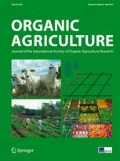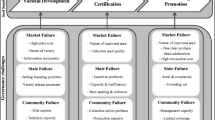Abstract
This article reviews and analyses the evolution of organic seed regulation in the USA, as a model case of how challenges in a new regulatory area are being addressed. The study draws on formal interviews of key stakeholders, participant observation and documents generated in a 6-year period between 2007 and 2013. The article addresses three main issues: (1) how proposals for the wording and implementation of the regulation constrain seed choices and give rise to unintended consequences, (2) how emergent organizations and procedures have responded to the tension between sustaining seed differentiation to match the characteristics of local markets, organic production and agro-ecologies, and the narrowing of varietal choice in catalogued seed so as to expand commercial organic seed markets and encourage organic seed breeding and (3) why consensus on the content of formal seed policy has failed to develop despite a high level of stakeholder engagement. The study revealed that the official guidance on the interpretation of the regulation has not been sufficiently decisive to prevent divergent interpretation and practices, and therefore, the needs of a rapidly growing economic sector are not being met. The article concludes by drawing lessons for key areas of regulatory interpretation and practice and by identifying possible ways to make organic seed governance more effective.
Similar content being viewed by others
Abbreviations
- ACA:
-
Accredited Certifier Association
- AMS:
-
Agricultural Marketing Service
- AOSCA:
-
Association of Official Seed Certifying Agencies
- ASTA:
-
American Seed Trade Association
- ATTRA:
-
Appropriate Technology Transfer for Rural Areas
- FFSC:
-
Family Farmers Seed Cooperative
- IFOAM:
-
International Federation of Organic Agriculture Movements
- JC & CAC:
-
Joint Crops and Compliance, Accreditation and Certification Committee
- NOP:
-
National Organic Program
- NOSB:
-
National Organic Standards Board
- NOVIC:
-
Northern Organic Vegetable Improvement Collaborative
- OFPA:
-
Organic Foods Production Act
- OFRF:
-
Organic Farming Research Foundation
- OMRI:
-
Organic Materials Review Institute
- OREI:
-
Organic Research and Education Initiative
- OSA:
-
Organic Seed Alliance
- OSP:
-
Organic Seed Partnership
- OTA:
-
Organic Trade Association
- PSI:
-
Public Seed Initiative
- SARE:
-
Sustainable Agriculture Research and Education
- SOS:
-
State of Organic Seed
- USDA:
-
United States Department of Agriculture
References
Accredited Certifiers Association (ACA) (2008) Further guidance on commercial availability of organic seed, September, 22, 2008. Available from URL: http://www.accreditedcertifiers.org/wp-content/uploads/2013/02/Further-Guidance-on-Commercial-Availability-of-Seed_11.2008.pdf/
Adam K (2005) Seed production and variety development for organic systems. Appropriate Technology Transfer for Rural Areas (ATTRA). Available from URL: https://attra.ncat.org/attra-pub/organic_seed/
Colley M, Baker B (2010) Sourcing certified organic seed and the national organic program regulations. Available from URL: http://www.extension.org/article/18338/print/
DeLeon P, DeLeon L (2002) What ever happened to policy implementation? An alternative approach. J Public Adm Res Theory 12(4):467–492
Denzin N, Lincoln Y (1994) Handbook of quantitative research. Sage Publications Inc., Thousand Oaks
Dillon M, Hubbard K. (2011) Organic Seed Alliance: State of organic seed report. Available from URL: http://seedalliance.org/uploads/publications/SOS_2011_Report.pdf/
Döring TF, Bocci R, Hitchings R et al. (2012) The organic seed regulations framework in Europe—current status and recommendations for future development. Organic Agriculture doi:10.1007/s13165-012-0034-7
Hal PA, Taylor RCR (1996) Political science and the three new institutionalisms. Political Studies XLIV, pp. 936–957
Howard PH (2009) Visualizing consolidation in the global seed industry: 1996–2008. Sustainability 1(4):1266–1287
Hubbard K (2012) AOSCA announces new organic seed database. Available from URL: http://blog.seedalliance.org/2012/09/26/new-organic-seed-database-announced/
IFOAM (International Federation of Organic Agriculture Movements) (2012). The IFOAM norms for organic production and processing, version 2012. Available at URL: www.ifoam.org/
Jiggins J, Collins K (2003) Stakeholders and stake holding in social learning for integrated catchments management and sustainable use of water. In: Social Learning for the Integrated Management (SLIM) Thematic Paper, pp 28
Kickert WJM, Klijn HE, Koppenjan JFM (1997) Introduction: a management perspective on policy networks. In: Kickert WJM, Klijn HE, Koppenjan JFM (eds) Managing complex networks: strategies for the public sector. Sage Publications Ltd., London, pp 2–13
Klein K, Winickoff DE (2011) Organic regulation across the Atlantic: emergence, divergence, convergence. Environ Polit 20(2):153–172
Krippendorff K (2004) Content analysis: an introduction to its methodology, 2nd edn. Sage Publications, Inc., Thousand Oaks
Kvale S (1996) Interviews: an introduction to qualitative research interviewing. Sage Publications, Inc., Thousand Oaks
Lammerts van Bueren ET, Struik PC, Jacobsen E (2002) Ecological concepts in organic farming and their consequences for an organic crop ideotype. Neth J Agric Sci 50:1–26
Luttikholt LWM (2007) Principles of organic agriculture as formulated by the International Federation of Organic Agriculture Movements (IFOAM). Neth J Agric Sci 54(4):346–360
MacDougall NA (2005) The certified organic seed market: implications of delayed development. A report prepared for the California Institute for the Study of Specialty Crops (CISSC). Available from URL: http://www.cissc.calpoly.edu/research/49942FinalReport.pdf/
May C, Finch T (2009) Implementing, embedding and integrating: an outline of normalization process theory. Sociology 43(3):535–554
Meuleman L (2008) Public management and the metagovernance of hierarchies, networks and markets. Physica-Verlag, Heidelberg
NOP (National Organic Program) (2011) Draft guidance seeds, annual seedlings, and planting stock in organic crop production. NOP 5029, June 13, 2011. Available from URL: http://www.ams.usda.gov/AMSv1.0/getfile?dDocName=STELPRDC5091383/
NOP (National Organic Program) (2013) Draft guidance seeds, annual seedlings, and planting stock in organic crop production. NOP 5029, March 4, 2013. Available from URL: http://www.ams.usda.gov/AMSv1.0/getfile?dDocName=STELPRDC5102731
NOSB (National Organic Standards Board) (2001) Commercial availability, March 21, 2001. Available from URL: http://www.ams.usda.gov/AMSv1.0/getfile?dDocName=STELPRDC5060373/
NOSB (National Organic Standards Board) (2005) Recommendations on commercial availability of organic seed, August 17, 2005. Available from URL: http://www.ams.usda.gov/AMSv1.0/getfile?dDocName=STELDEV3104462/
NOSB (National Organic Standards Board) (2008c) Commercial availability of organic seed, November 19, 2008. Available from URL: http://www.ams.usda.gov/AMSv1.0/getfile?dDocName=STELPRDC5074861/
NOSB (National Organic Standards Board) Joint Crops and CAC Committee (2007) Recommendations on further guidance on the establishment of commercial availability criteria, November 30, 2007. Available from URL: http://www.ams.usda.gov/AMSv1.0/getfile?dDocName=STELPRDC5066630&acct=nosb/
NOSB (National Organic Standards Board) Joint Crops and CAC Committee (2008a) Further guidance on commercial availability of organic seed, April 3, 2008. Available from URL: http://www.ams.usda.gov/AMSv1.0/getfile?dDocName=STELPRDC5068445&acct=nosb/
NOSB (National Organic Standards Board) Joint Crops and CAC Committee (2008b) Further guidance on commercial availability of organic seed, September 22, 2008. Available from URL: http://www.ams.usda.gov/AMSv1.0/getfile?dDocName=STELPRDC5072618&acct=nosb/
OFPA (Organic Food and Production Act) (1990), Title XXI of the 1990 Farm Bill of Public Law 101–624, The Food, Agriculture, Conservation, and Trade Act of 1990. Available from URL: http://www.ams.usda.gov/AMSv1.0/getfile?dDocName=STELPRDC5060370/
OTA (Organic Trade Association) (2011) OTA task force draft comments: National Organic Program: Notice of draft guidance NOP 5029: seeds, annual seedlings, and planting stock in organic crop production. AMS-NOP-11-0002: NOP-11-02. August 12, 2011. Available from URL: http://www.ota.com/pp/otaposition/Seeds-Annual-Seedlings-and-Planting-Stock.html
OTA (Organic Trade Association) (2012) OTA’s 2012 Organic industry survey. Brattleboro, VT. Available from URL: https://www.ota.com/bookstore/14.html/
Patton MQ (1980) Data analysis: qualitative evaluation methods part III. Sage Publications, Ltd., London, pp 267–347
Peters GB, Pierre J (1998) Governance without government? Rethinking public administration. J Public Adm Res Theory 8(2):223–243
Podoll TM (2009) Participatory plant breeding’s contribution to resilience and the triple bottom line of sustainability—healthy ecosystem, vital economy, and social inclusion. Master of Science Thesis, Iowa State University
Reed MS, Graves A, Dandy N et al (2009) Who’s in and why? A typology of stakeholder analysis for natural resource management. J Environ Manag 90(5):1933–1949
Reganold JP, Jackson-Smith D, Batie SS et al (2011) Transforming U.S. agriculture. Science 332:670–671
Renaud ENC, Lammerts van Bueren ET, Jiggins J (2014) Comparative analysis of the organic seed regulations in the United States, European Union and Mexico. Submitted to International Journal of Agricultural Sustainability
Rhodes RAW, (1996) The new governance: governing without governance. Political Studies XLIV: 652–667
Steimo S (2008) What is historical institutionalism? In: Porta DD, Keating M (eds) Approaches and methodologies in the social sciences: a pluralist perspective. Cambridge University Press, Cambridge, pp 118–138
Stolze M, Lampkin N (2009) Policy for organic farming: rationale and concepts. Food Policy 34:237–244
United States Department of Agriculture (USDA), Agricultural Marketing Service (AMS) (2002) 7 CFR Part 205 National Organic Program Standards. Available from URL: www.ams.usda.gov/nop/standards/
Waterman RW, Meier KJ (1998) Principal-agent models: an expansion? J Public Adm Res Theory 8(2):173–202
Willer H, Kilcher L (eds) (2012) The world of organic agriculture—statistics and emerging trends 2011. Research Institute of Organic Agriculture (FiBL), Frick, Switzerland and International Federation of Organic Agriculture Movements (IFOAM), Bonn, Germany
Author information
Authors and Affiliations
Corresponding author
Rights and permissions
About this article
Cite this article
Renaud, E.N.C., Lammerts van Bueren, E.T. & Jiggins, J. The development and implementation of organic seed regulation in the USA. Org. Agr. 4, 25–42 (2014). https://doi.org/10.1007/s13165-014-0063-5
Received:
Accepted:
Published:
Issue Date:
DOI: https://doi.org/10.1007/s13165-014-0063-5




